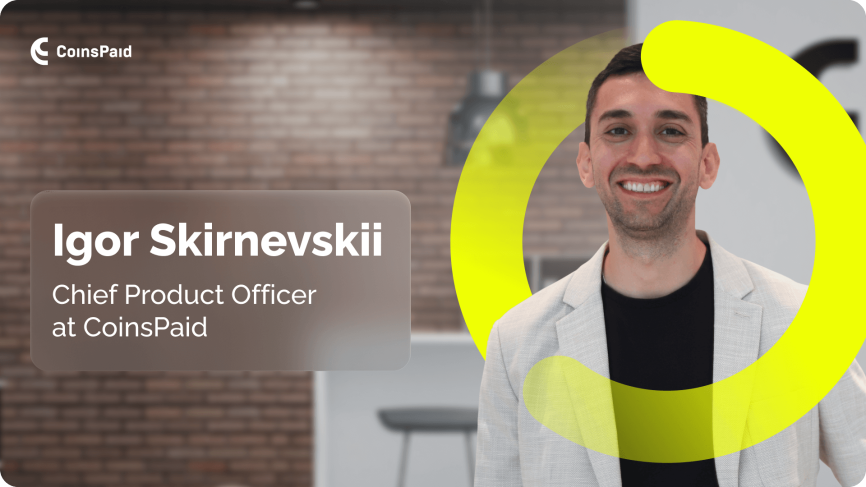The best moment is when you create your own ‘Bosporus,’ and those who used to navigate around their ‘Africa’ come to you

According to Igor Skirnevskii, Chief Product Officer at CoinsPaid, the most exciting part of product leadership is supporting exceptional people in creating outstanding products and, whenever possible, not getting in their way. He believes that great product teams excel at finding the intersection of customer needs, technical solutions, and revenue generation, but truly great teams thrive where empathy for clients and common goals resides. Join us as we explore the product world of CoinsPaid with Igor Skirnevskii. Follow his journey to discover the key trends shaping the fintech industry today, how feature developments are prioritised at CoinsPaid, and much more.
Tell us about your background in product leadership. What was it that you loved so much from the outset?
Since the days when I was actively engaged in science, long before I ventured into fintech, my life has been strongly connected to product development and leadership. Notably, I left the scientific field because most of our research ended up gathering dust on the shelf. What’s more interesting, the majority of our clients didn’t really need the solutions they requested. What I love most about the product is its potential to perform some kind of “work,” improve something ineffective, or make complex tasks easier. The best moment for any product leader is when you create your own ‘Bosporus,’ and those who used to navigate around their ‘Africa’ come to you. They’re ready to pay for your solutions and support their development because it’s certainly a win-win situation for everyone involved.
Has there ever been a career-defining moment for you?
Yes, it was a moment of fatigue, a time when I had to push myself to the limit, staying up late nights poring over programming books, and returning to the office to tackle mentally demanding tasks. At the same time, I started to realise that I feel truly comfortable during business trips, engaging with clients, discussing product concepts, and addressing their core issues. One day, it hit me—I realised I was much better at building communication between clients and developers, identifying pain points, and fostering growth opportunities rather than at coding.
What makes an excellent product team and product manager?
I’m sure Google will provide the specific and correct answer to this question, but personally, I believe that great product teams excel at finding the right spot on a coordinate system. This spot is defined by the combination of customer needs, technical solutions, and a way for revenue generation. Once there’s a tilt towards any one side, products end up being something only their creators find in demand. I believe the Product Team serves as a constant reminder of our founding goal: to provide the most effective solutions to our customers’ problems. This principle guides every decision we make, from product development to customer support. It’s not just about creating innovative features; it’s about understanding the real needs and challenges our customers face and addressing them with precision and empathy.
What’s the most exciting part of being a product leader?
The most exciting part of product leadership lies in the opportunity to make an impact on people’s (or in our case companies) lives. As a product leader, you get to shape the vision and strategy of a product from inception to launch, guiding a team toward a common goal. It’s incredibly rewarding to see an idea evolve into a successful product that solves real problems for customers.
Moreover, you have to balance customer needs, market trends, and business goals, which keeps the work engaging and challenging. Collaborating with cross-functional teams, designers, engineers, marketers, and sales provides a holistic view of the business and enriches your perspective.
How would you describe your main responsibilities as a CPO at CoinsPaid?
If you Google it, the top result of course would likely be “developing product strategy.”
Overall, I agree that product strategy and vision is important for any company. But at the moment this is not our bottleneck.When I joined the company, I noticed that our teams were quite fragmented, each pursuing its own objectives. This led to the company moving in many different micro-directions. I think that my main goal at the moment is to foster a sense of unity and common purpose, and build teams that help each other and moves in the same direction.
What do you consider the greatest strength of a CPO in a fintech company, and how does it help in the role?
It all depends on the company’s needs. A CPO, like any other employee, sells their expertise in the area where the company is lacking at the moment. This could be experience in implementing product processes, domain knowledge, expertise in adapting products to regulatory requirements, or introducing growth techniques. As I mentioned, it all depends on the specific context and needs. Perhaps, the difference between fintech and other domains is that fintech is an over-regulated field. Often, these restrictions negatively affect the user experience. A distinctive feature of product managers in fintech is that they need to find a balance between simplifying their clients’ lives while meeting strict regulatory requirements.
How has CoinsPaid’s product department evolved over time? Could you share some insights into its overall vision and mission?
Our product department is relatively young. Like elsewhere, the main trajectory of its development has been dictated by the company’s culture and the vision of the CEO. Notably, CoinsPaid’s product department has undergone very significant transformations, from closer alignment with business and marketing to deep integration with engineering teams. Currently, we are trying to occupy a central position between business and engineering. With such diverse versions and perspectives on the product department, we have to redefine our values and areas of responsibility to bring as much benefit to the company as possible. We aim to balance the needs of our existing customers with the strategic initiatives required to enter new markets and try to turn all this into a sustainable strategy of our product development.
What are the most significant trends shaping the fintech industry today, and how do you leverage these trends in your role?
Today, the fintech industry is making banking, financial services, and digital currencies more accessible to a wider audience. For example, in the USA, we’re witnessing significant growth in interest in DeFi projects, which shows that a large portion of the population will own crypto assets shortly. What’s more, we find ourselves in a cutthroat market with numerous regulatory requirements. This means that as a company, we have to compete not just functionally, but by constantly enhancing the efficiency of our products. Another emerging trend is the establishment of a regulatory framework for crypto-assets, issuers, and service providers, such as payment gateways and many other areas. Undoubtedly, clear regulations make the crypto market more transparent for users and should attract both major players and private investors. At CoinsPaid, we already have partnerships with service providers like Chainalysis, Crystal, and NoteBene. We are fully committed to complying with regulatory requirements and actively participating in AML and CFT.
How do you prioritise feature development and enhancements in your product roadmap, balancing customer feedback, market trends, and internal innovation?
Since resources are limited in any company, efficient prioritisation emerges as the primary task of the product team. In CoinsPaid we analyse the phase of the Moon and the stars location to make a decision about new features we want to implement. But sometimes we turn back to our product strategy evolving along three key directions: regulatory compliance and security, tailoring our solution to the needs of existing merchants, and adapting the product for scaling to new markets. It’s clear the first direction has the highest priority. Maintaining licences and security is our non-negotiable focus. We must ensure the security of our merchants’ funds as well as provide services that function without interruptions. The other two directions often compete with each other. That is why we employ a model that considers implementation costs versus potential benefits.
Can you walk me through the typical lifecycle of a product or feature at CoinsPaid, from ideation to launch and beyond? What factors influence decision-making at each stage?
There is an opinion that CoinsPaid is a data-driven company, and we utilise four main sources of insights to guide our decisions. These include feedback from our merchants, the expertise of our R&D team, which is always exploring new technological solutions, and our discovery activities, which involve market analysis, competitor research, and tracking new regulations and trends. Last but not least is our vision—where we aspire to be and what services we want to offer in the future. Every new idea undergoes a preliminary analysis. We aim to assess the solution’s potential and impact on our North Star metric. Afterward, we determine the priority of the task, considering factors like complexity and potential value. However, there are exceptions, such as regulatory requirements or security vulnerabilities, which have fixed delivery dates and a separate pipeline. If a task has a high priority, it enters the standard development cycle, which includes technical analysis, implementation, and release. Overall, the whole product development is a series of trials, errors, and experiments where you validate product hypotheses. Our goal is to minimise the costs of validating these hypotheses and quickly receive feedback from the market since any idea, even the most obvious, can turn out to be inconvenient for users. That’s why the final word always belongs to our customers.
Provide an example of a time when you had to make a difficult decision regarding a product you were overseeing.
One of the recent examples is about initiatives related to entering low-risk markets, which appear very attractive and motivate our employees. It’s always gratifying to see our logo on websites like Ferrari or Walmart. Moreover, this enhances the brand’s appeal and can be a source of viral traffic. However, on the flip side, we know that the appeal of crypto payments among low-risk users (especially in the e-commerce segment) remains quite limited, and consumers are used to covering their needs with fiat as the most accessible means of payment, simply because a Visa card is always at hand, and that’s where they receive a salary. Ignoring this reality could lead us astray, investing all efforts in low-risk ventures and ultimately yielding no profit. At present, we’ve decided to cautiously test our capabilities in low-risk markets and progress through small iterations. Meanwhile, tasks related to the needs of our existing merchants take precedence. In a year, we’ll revisit this decision and see how accurate our choice was.
Looking ahead, what’s next for you and CoinsPaid? Are there any exciting developments or projects on the horizon that you can share?
I sincerely hope that our next major step will be entering the US market. It looks incredibly promising. We’ve already done a tremendous amount of legal work to obtain and activate licences, but there are still many challenges ahead. The engagement of US users in the digital financial services market and the number of companies in the Web3 space present significant opportunities for companies that provide cryptocurrency payment services and tools. I’m also confident that our interest in the low-risk segment and e-commerce companies can significantly boost our technology stack. E-commerce has completely different demands for transaction speed, returns, supplier settlements, and user convenience. I believe we have all the necessary resources to meet these requirements.



